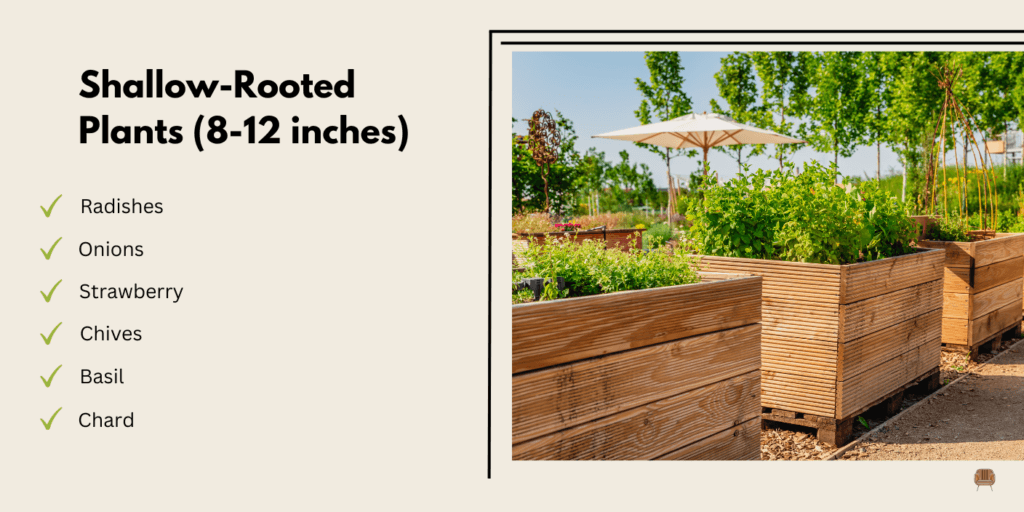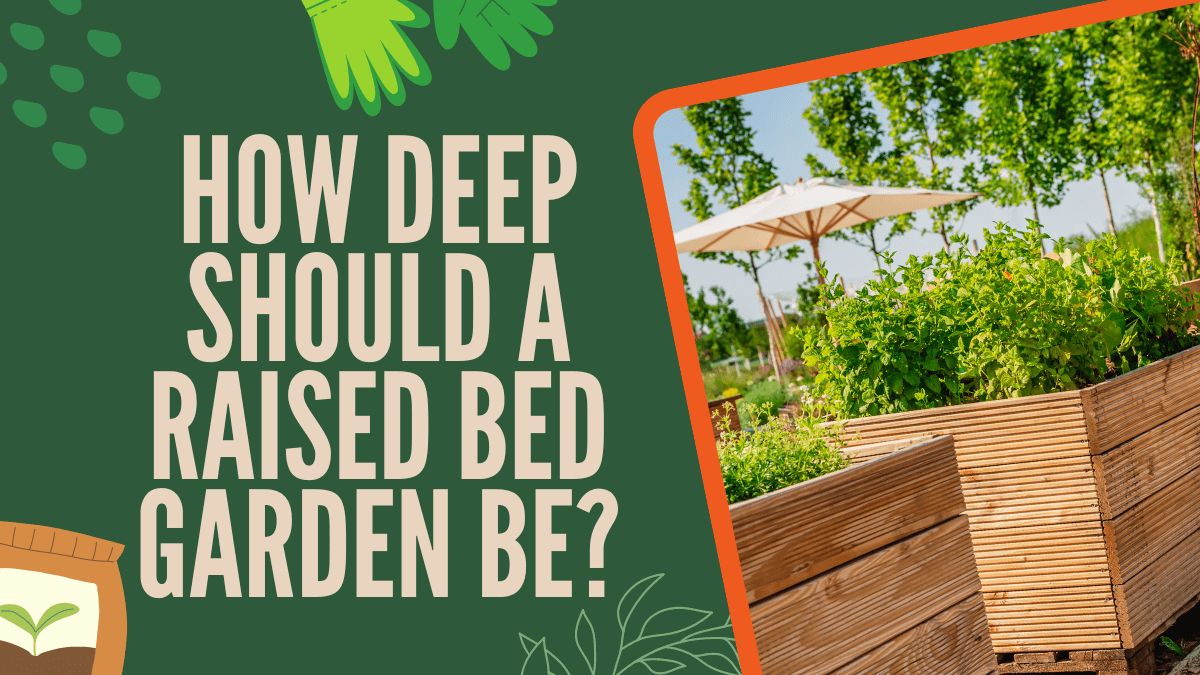If you’ve ever dreamed of growing fresh veggies, fruits, or flowers right in your backyard, you’re probably familiar with the idea of raised bed gardens. They’ve become incredibly popular for their flexibility, ease of maintenance, and accessibility for everyone, even those with smaller spaces. However, I often ask myself, “How deep should a raised bed garden be?“
The answer depends on what you want to grow and the conditions of your yard. But in general:
A raised bed should ideally be 8-12 inches deep (20-30 cm) and provide enough space for most plants to grow healthy roots.
Table of Contents
What is a Raised Bed Garden?
Before we get into the specifics of depth, let’s define what a raised bed garden is. Essentially, it’s a contained area of soil that is built above ground level, either with wooden planks, bricks, or any sturdy material that can create a boundary.
Raised beds allow you to control the quality of your soil, improve drainage, and make gardening easier on your back. Plus, they’re a great option for people who have poor or compacted soil in their yard.

Our garden has loamy soil and is very rocky in some areas, making it difficult for me to till. That’s why raised beds are such a great option for us!
Why Does the Depth of a Raised Bed Matter?
The depth of your raised bed garden plays a significant role in the health of your plants. The deeper the soil, the more room your plant roots have to grow and spread. Deeper beds also provide better drainage and moisture retention, which can be crucial depending on the types of plants you’re growing and the local climate.
Roots Need Room to Grow
Think of plant roots like an iceberg – what you see above ground is just the tip. Most of a plant’s growth happens under the soil, where roots absorb nutrients and water. If your bed isn’t deep enough, those roots might struggle to grow properly, leading to weaker and less productive plants.
Standard Raised Bed Depth

So, how deep should your raised bed garden be? For some garden plants, at least a depth of 8 inches (20 cm) is good.
And 12-24 inches (30-60 cm) deep is typically sufficient for many medium-rooted plants (cucumbers and turnips) and with big root systems like watermelons, sunflowers, and pumpkins.
However, different plants have different needs, so this is where knowing what you plan to grow comes into play.
Minimum Depth for Raised Beds: 8 inches
The absolute minimum depth for a raised bed should be 8 inches (20 cm), but this depth is only suitable for shallow-rooted plants like lettuce, spinach, herbs, and radishes. If you’re sticking with these smaller, quick-growing plants, a shallower bed will save you on soil costs while still giving you good results.
If you’re working with an 8-inch bed, make sure to place it in an area where you can access rich soil below the raised bed, such as on top of fertile ground. That way, the roots can reach deeper if necessary.
Ideal Depth for Most Plants: 8-12 inches

For most vegetable gardens, a bed that is 8-12 inches (20-30 cm) deep will offer enough room for the majority of plants to grow well. Plants like cabbage do just fine in this range. This depth allows for proper root development, good moisture retention, and proper drainage.
I find that this depth is a great middle ground. Not only does it allow to grow a wide variety of plants, but it’s also a manageable depth when it comes to filling the bed with soil.
I like to use a mix of compost, peat moss, perlite, and quality garden soil to ensure that my plants are getting a nutrient-rich environment from the get-go.
Medium Beds for Root Vegetables: 12-18 inches

If you’re planning to grow root vegetables like carrots, beets, peppers, cucumbers, beans, or parsnips, you’ll want to go deeper – 12-18 inches (30-45 cm) is ideal.
Root vegetables need plenty of room to stretch out beneath the soil, and a shallow bed will result in short, stubby crops that don’t have the space to develop properly.
Deep Beds: 18-24 inches

For gardeners who want to plant particularly deep-rooted crops (like certain fruit trees, sunflowers, corns, and large shrubs), or if you’re looking to maximize soil depth for a lush, multi-tiered garden, building beds that are 18-24 inches (45-60 cm) deep might be necessary.
While this depth isn’t required for most home gardens, it can be useful for those looking to grow larger plants or trees in their raised beds.
How to Choose the Right Soil Depth for Your Raised Bed Garden
Now that you know the various depth requirements for different types of plants, how do you decide what’s right for you?
Consider Your Plant Choices
If you’re planning a raised bed for a small herb garden or shallow-rooted plants, you can save time and money by sticking to a depth of at least 8 inches (20 cm).
But if you want a diverse vegetable garden with tomatoes, carrots, beans, zucchini, etc. aim for a bed that’s 12-18 inches (30-45 cm) deep.
If you’re planting deep-rooted crops or trees, don’t hesitate to go for a depth of 18-24 inches (45-60 cm) or more.
Think About Long-Term Goals
Consider how your garden will change over time. Will you always grow shallow-rooted plants, or do you see yourself expanding to root vegetables or large perennials?
Starting with a bed that’s slightly deeper than you initially need can give you more flexibility down the road without having to rebuild or modify your bed later.
For me, raised beds should be deeper, even a little too much, than too shallow and ineffective.
Location and Climate
If you live in an area with a short growing season or poor ground soil, a deeper bed might help you extend your growing season by providing better insulation and drainage for your plants.
Raised beds warm up faster in the spring, which can give you a head start on planting. Similarly, if your yard tends to stay waterlogged after rain, a deeper bed will allow for better drainage and prevent root rot.
How to Choose the Right Location for Your Raised Bed Garden
Choosing the right location for your raised garden beds is crucial for the success of your garden. Proper placement ensures your plants get enough sunlight, have good drainage, and are easy to maintain.

Once you’ve chosen a spot that balances convenience with optimal growing conditions, you’ll create a productive and enjoyable garden that you can easily maintain and enjoy for seasons to come!
1. Sunlight Exposure
Most vegetables and fruits require plenty of sunlight to thrive, typically 6-8 hours of direct sunlight per day. Sunlight plays a significant role in photosynthesis, which helps your plants grow strong and produce healthy crops.
How to Determine Sunlight Exposure
Observe your yard throughout the day to see which areas get the most sunlight. Mornings and afternoons are ideal times to check.
Avoid shady spots created by large trees, buildings, or fences. Too much shade will lead to weaker plants and smaller yields.
If you’re growing shade-tolerant plants, like lettuce or spinach, partial sun (4-6 hours) can work, but for sun-loving plants like tomatoes, peppers, and squash, go for the sunniest spot.
Tip: For sunny urban or small backyard spaces, raised beds can be placed near a sunny wall, patio, or deck.
2. Accessibility and Convenience
Having your raised bed in an accessible location makes it easier to maintain and harvest. The closer your beds are to your home or water source, the more convenient it will be for daily care.
Consider the following:
- Proximity to water
Make sure your bed is near a water source, whether it’s a garden hose or rainwater collection system. This will make watering your plants much easier, especially during the hot months.
- Pathways and space
Leave enough space between beds and other structures for you to walk comfortably and access your plants. A 2-3 foot (60-90 cm)-wide path between raised beds is ideal.
- Tools and materials
Position your raised beds near your gardening tools, shed, or compost pile so everything is easily accessible when you’re working in the garden.
3. Soil Drainage
Good drainage is essential for raised beds to prevent waterlogging and root rot. Raised beds typically offer better drainage than traditional garden beds, but their location can still affect how well they drain.
To Ensure Good Drainage:
- Avoid low-lying areas
These areas tend to collect water after heavy rains, leading to waterlogged soil, which can harm plant roots. Choose a higher ground location where water can naturally flow away.
- Check the soil underneath
If the soil underneath your bed is heavy clay or tends to hold water, adding a layer of gravel or coarse sand under the raised bed can improve drainage.
- Consider slope
Place your bed on a level surface to avoid uneven water distribution. If your yard has a slope, consider leveling the ground to ensure even drainage. An uneven surface can cause some parts of the bed to dry out faster while others stay too wet, making it harder for plants to grow evenly.
4. Wind Protection
Strong winds can damage plants, dry out the soil, and make your garden less productive. To protect your raised bed garden from excessive wind, look for natural windbreaks like fences, walls, or hedges that can shield your plants from the wind.
If you don’t have natural windbreaks, consider planting tall shrubs or installing a garden screen to protect your beds.
Avoid placing your raised bed directly next to tall structures that might create wind tunnels, which could amplify the wind rather than reduce it.
5. Level Ground
A raised bed should sit on level ground to prevent water from pooling in certain areas or running off too quickly from others.
How to Level the Ground
If your yard isn’t naturally level, you can either flatten the area with a shovel or construct terraced beds that follow the natural slope of the land.
Ensure the bed is stable and doesn’t shift or tilt once placed.
6. Avoid Contaminated Areas
Be mindful of what’s underneath and around your chosen location. Soil contamination from chemicals, heavy metals, or other pollutants can affect the quality of your crops and the health of your garden.
Tips to Avoid Contamination
- Keep distance from busy roads
Raised beds should be placed away from areas where vehicles frequently pass, as pollution from car exhausts can settle in the soil.
- Steer clear of treated wood or old construction sites
If your yard was previously used for construction or industrial purposes, the soil might be contaminated with chemicals.
- Test your soil
Before starting, it’s a good idea to get a soil test, especially if you’re unsure about the history of your land. While raised beds use new soil, you’ll want to be sure the area around it is safe.
7. Watch Out for Tree Roots
While shade from trees can be an issue, tree roots can also be problematic. Large, established trees have root systems that will compete with your raised bed plants for water and nutrients.
Tips to Avoid Tree Root Competition
- Plant away from large trees
Try to position your raised beds at least 10-15 feet (3-4 m) from mature trees to prevent root competition.
- Root barriers
If space is limited, consider installing a root barrier around your raised bed to keep tree roots from encroaching.
8. Climate Considerations
If you live in an area with a particularly hot or cold climate, take your region’s weather into account when choosing the bed’s location.
- Hot climates
In very sunny, hot areas, placing your raised bed in a spot that gets some afternoon shade can help prevent your plants from wilting or drying out.
- Cold climates
In cooler regions, placing your raised bed in a full-sun area, possibly near a heat-retaining wall or structure, can extend your growing season.
BONUS:
- Experiment and adapt
If you’re not sure about the location, don’t hesitate to try things out. Gardening is a learning experience, and you can always make adjustments along the way.
Special Considerations for Raised Bed Depth

Your Native Soil
One thing to keep in mind is the quality of the ground soil under your raised bed. If the natural soil in your yard is hard, compacted clay, or full of rocks, it’s best to build a deeper bed so that your plants don’t have to struggle to grow into that tough layer.
On the other hand, if you have decent soil underneath, you may be able to get away with a slightly shallower bed since the roots can extend down into the earth.
Drainage Needs
Drainage is another important factor to consider. Raised beds that are too deep can sometimes struggle with drainage, especially if your soil mix is too dense or if your bed is built directly on concrete.
In this case, you might want to add a layer of gravel or coarse material at the bottom to help excess water flow out. However, too much drainage can dry out the soil quickly, so strike a balance depending on your plants’ needs.
Accessibility and Mobility
A great thing about raised beds is how they can be customized to suit your needs. If you have trouble bending or kneeling, consider building taller beds (18-24 inches / 45-60 cm) that allow you to garden at waist height.
This is an especially great option for seniors or anyone with mobility issues. Not only does it make gardening easier on your body, but it also looks fantastic as a structural element in your yard.
Cost and Materials
It’s no secret that the deeper your raised bed, the more soil you’ll need to fill it. This can add to your project’s cost, especially if you’re using high-quality organic soil and compost. However, there are ways to cut costs while still giving your plants what they need.
One trick is filling the bottom half of very deep raised beds with a layer of organic materials that break down over time, like logs or another woody material, leaves, and straw. This technique, called “Hugelkultur,” not only saves on soil but also improves the long-term fertility of your bed as the material decomposes.
How Much Soil Do I Need to Fill a Raised Bed?
To fill a raised bed, you’ll need to calculate the volume by multiplying the length, width, and height of the bed (all in feet). The formula is:
Length x Width x Depth (or height) = Cubic feet of soil needed.
For example, if your raised bed is:
- 4 feet long (Length)
- 4 feet wide (Width)
- 1 foot deep (Height or Depth)
The calculation would be:
4 feet (Length) x 4 feet (Width) x 1 foot (Depth) = 16 cubic feet of soil.
This is how you calculate the total volume of soil you need to fill your raised bed. Make sure to measure all three dimensions in feet.
Most garden centers sell soil in cubic feet or cubic yards, so check the packaging to know how much to buy. Easy and done!
What to Fill Raised Beds With?
To fill a raised bed, use a mix of organic materials for healthy soil.
- Base Layer
Put a layer of materials like cardboard, newspaper, or landscape fabric to block weeds.
- Middle Layer
Add organic materials like straw, leaves, grass clippings, or twigs, which will break down over time and enrich the soil.
- Top Layer
Fill the top with a blend of high-quality garden soil and compost (typically a 60/40 or 50/50 mix) for healthy plant growth.
What Do You Put in the Bottom of a Raised Garden Bed?
Soil is the best option for the bottom of a raised garden bed because it is nutrient-rich, promotes healthy root development, supports beneficial microorganisms, and provides good drainage.

This long-term investment helps your plants grow strong and resilient, ultimately leading to better yields!
Cost-Effective Alternatives
If high-quality soil is too expensive for you, consider these options. Using a mix of these alternatives can help you create a productive growing environment while managing costs. Over time, the health of your plants will benefit from your investment in good soil or well-thought-out substitutes!
- Homemade compost
Create your compost from kitchen scraps, yard waste, and grass clippings. It’s free and enriches the soil over time.
- Soil amendments
Mix less expensive materials like peat moss, coconut coir, or well-rotted manure with a smaller amount of quality soil to stretch your budget.
- Wood chips or straw
Use a layer of wood chips or straw at the bottom to help with drainage, then add a less expensive soil mix on top. This will break down over time and improve the soil.
- Topsoil
If you can find affordable topsoil, it can be a budget-friendly option. Just make sure it’s not too compacted and has good drainage.
- Cardboard
It’s affordable (often free from old boxes), biodegradable, and helps suppress weeds while allowing water and nutrients to penetrate. It breaks down over time, enriching the soil.
- Burlap
Also inexpensive and biodegradable, burlap allows for proper drainage and airflow. It’s a sturdy, natural material that can be easily sourced from old sacks or fabric stores.
Avoid
Plastic is not a good option for the bottom of a raised bed because it blocks drainage, causing water to pool and potentially leading to root rot. Trapped moisture can create soggy, unhealthy conditions for plants.
Additionally, plastic doesn’t break down or contribute nutrients to the soil, which can affect plant growth in the long term. It also restricts airflow to the soil, which is crucial for healthy roots and beneficial microorganisms.
Using breathable materials, like cardboard or natural fabric, allows for better drainage and soil health.
What are Three of the Most Popular Raised Bed Sizes

These sizes are ideal for most garden layouts and make planting, watering, and harvesting simple!
- 4×4 feet – Great for small spaces and beginner gardeners.
- 4×8 feet – A versatile size that offers more planting space while still being easy to manage.
- 3×6 feet – Narrower width for easier reach, perfect for tighter spaces or limited mobility.
What is the Best Height, Width, and Length for Raised Beds?

These sizes offer easy access and enough depth for most plants to thrive!
- Height: 8-12 inches (deeper beds are better for root growth).
- Width: 3-4 feet (so you can easily reach the middle from both sides).
- Length: 6-8 feet (manageable size, but can vary based on space).
What are The Best Raised Garden Bed Materials?
Each material has its pros and cons, but these are popular choices for durability and garden aesthetics!
- Cedar or Redwood
Naturally rot-resistant and long-lasting.
- Metal
Durable, rust-resistant options like galvanized steel are great for a modern look.
- Composite Wood
A mix of wood, it’s weather-resistant and low-maintenance.
- Concrete Blocks or Bricks
Strong and long-lasting, though they can retain heat.
Steel Beds, Rolling Raised Beds, and Stone Beds
- Steel Beds
Durable and modern-looking, galvanized steel beds resist rust and last for years. They heat up faster in the spring, which can be great for early planting, but they might get hot in the summer, so watch your plants.
- Rolling Raised Beds
These are great for flexibility! Perfect for patios or small spaces, they let you move your garden to follow the sun or to protect plants from the weather. Ideal for small herbs or veggies.
- Stone Beds
Beautiful and super durable, stone beds (made from natural rocks, bricks, or concrete blocks) are permanent and sturdy. They provide great insulation for soil but are more labor-intensive to build.
What is The Best Way to Water Plants in a Raised Bed?
- Water at the base
Focus on the soil, not the leaves, to avoid disease and ensure roots get the moisture.
- Water deeply
Water slowly and thoroughly so the moisture reaches deep into the soil, encouraging strong root growth.
- Use soaker hoses or drip irrigation.
These systems provide consistent, slow watering and save time, making sure water goes directly to the roots.
Keep the soil consistently moist, but avoid waterlogging!
Tip: Water in the early morning or late evening. This reduces evaporation and gives plants time to absorb water before the heat of the day.
Raised Garden Beds vs In-Ground Gardening
Each method has its strengths, depending on your garden goals, space, and resources!
Raised garden beds are above-ground structures filled with soil, often framed with wood, metal, or stone.
Raised Garden Beds
Pros:
- Better drainage and soil control
- Warms up faster in the spring
- Easier to manage and weed
- Ideal for poor native soil
Cons:
- Initial cost and setup
- Requires more soil
- May dry out faster
In-Ground Gardening
In-ground gardening involves planting directly into the earth, using the natural soil already in place.
Pros:
- No setup cost
- Access to deeper soil for root growth
- Stays moist longer
Cons:
- Harder to control soil quality
- More susceptible to weeds and pests
- Requires more bending and kneeling for maintenance
Thank you very much for staying with me till the end. If you have any questions or something to say, you can use the comment section below.
Stay safe, and as always, happy gardening!


 ChatGPT
ChatGPT
 Perplexity
Perplexity
 Claude
Claude
Leave a Reply